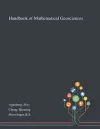
Handbook of Mathematical Geosciences
3 authors - Paperback
£60.45
B. S. Daya Sagar is Professor of the Systems Science and Informatics Unit (SSIU) at the Indian Statistical Institute, India. Earlier, he worked at the Andhra University College of Engineering, India, Centre for Remote Imaging Sensing and Processing (CRISP), The National University of Singapore, Singapore in various positions during 1992-2001, Multimedia University, Malaysia during 2001-07. In 2011, he received the Georges Matheron Lectureship Award from the International Association for Mathematical Geosciences. His research interests are concerned with several phases of studies on modeling the terrestrial dynamics, terrestrial pattern retrieval, terrestrial pattern analysis, simulation and modeling, reasoning and visualization of terrestrial phenomena and relevant geoscience processes. In addition to having authored and co-authored over 100 research papers in reputed journals, and has authored and/or guest edited 11 books and/or special theme issues for journals including "Mathematical Morphology in Geomorphology and GISci" (CRC Press, 2013) and "Handbook of Mathematical Geosciences: Fifty Years of IAMG" (Springer, 2018).
Qiuming Cheng did his Ph.D. in Earth Science under supervision of Dr. Frits Agterberg at the University of Ottawa in 1994. Cheng spent a year at the Geological Survey of Canada as a PDF under the supervision of Dr. Graeme Bonham-Carter, and soon became a faculty member at York University, Toronto, Canada in 1995 with cross appointments in the Department of Earth and Space Science and Engineering and the Department of Geography. He was promoted to associate professor in 1997 and full professor in 2002. He was awarded a Changjiang Scholar Professorship in China by the China Ministry of Education where he has set up and leads the State Key Lab of Geological Processes and Mineral Resources (GPMR) located on both campuses of China University of Geosciences in Beijing and Wuhan. Currently, he holds a Thousand Talent National Special Professorship of China, serving as the founding director of the GPMR lab. Cheng has specialized in mathematical geoscience with research focus on nonlinear mathematical modelling of earth processes and geoinformatics techniques for prediction of mineral resources. He has authored and coauthored more than 300 research articles. He has been awarded several prestigious awards including the Krumbein Medal, the highest award by the International Association for Mathematical Geosciences (IAMG). Cheng was an elected President of the International Association for Mathematical Geosciences (IAMG) during 2012-16. He is the president of International Union of Geological Sciences (IUGS) for the period between 2016 and 2020. Cheng is an international leader in the application of nonlinear mathematics and geoinformatics to the analysis, modelling and prediction of a wide range of geological processes and mineral resources quantitative assessment. Cheng’s primary research interest involvesthe interdisciplinary study of non-linear properties of the Earth’s systems, as well as quantitative assessment and prediction of natural resources and environmental impacts. His research on fractal density & local singularity analysis theory and geomathematical models have made major impacts in several geoscientific disciplines, including those concerned with ocean ridge heat flow, magmatic flare-up during continent crustal growth and formation of supercontinents, earthquakes, floods, hydrothermal mineralization, and prediction of deeply buried mineral deposits.
Jennifer McKinleyis a scientist from Northern Ireland, UK. She is currently a Reader at the School of Natural and Built Environment, Queen's University Belfast. As a Chartered Geologist, her research has focused on the application of spatial analysis techniques, including geostatistics, compositional data analysis and Geographical Information Science (GIS), to soil geochemistry, environmental and criminal forensics, human health, slope instability, airborne geophysics and weathering studies. She is the elected president of International Association for Mathematical Geosciences for the period during 2016-2020. Interdisciplinary collaboration and strong partnership working with multiple stakeholders, underpins all of her work, resulting in over 100 peer–reviewed international publications and conference presentations. Her research profile demonstrates a significant track record of sustained research contributions with high quality international publications stemming from RCUK and EU funding.
Frits Agterberg is a Dutch-born Canadian Mathematical Geologist who attended Utrecht University from 1954 to 1961. He helped establish the International Association for Mathematical Geosciences (IAMG) in 1968. In 1978 he received the IAMG's William Christian Krumbein Medal and was IAMG President from 2004 to 2008. He has authored or co-authored over 250 scientific papers and five books. After defending his doctoral thesis on structural geology of the Italian Alps and a postdoctorate fellowship at the University of Wisconsin in Madison, he became "petrological statistician" at the Geological Survey of Canada (GSC) in 1962. He was asked to create the GSC Geomathematics Section in 1971. He retired from the GSC in 1996 but still has an office at their Ottawa headquarters. In 1968, he became associated with the University of Ottawa where he taught a "Statistics in Geology" course for 25 years and has supervised six geomathematical PhD students. During the past 20 years, primarily in collaboration with Qiuming Cheng, his colleagues and students at the China University of Geosciences in Wuhan and Beijing and at York University, Toronto, he has worked on applications of multifractals to study the spatial distribution of metals in rocks and orebodies.